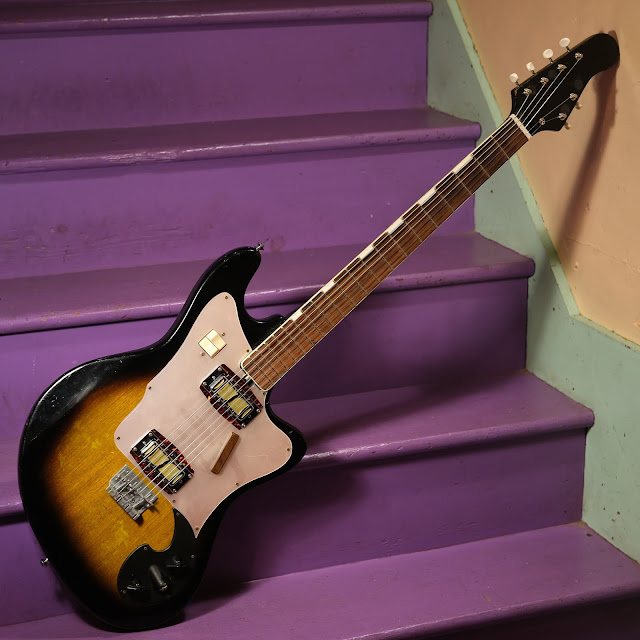1960s Teisco Baritone Electric Guitar Conversion
After playing a pair of Teisco EB-200s I'd converted to baritone guitars for a buddy of mine, my other buddy Todd wanted one himself. He found a different -- but similar -- 30" short scale Teisco bass to convert on Reverb and then left it here until he could come back to dig into it. He wanted to do the work himself!
So, with a lot of guidance and help, he managed to get this done-up as a baritone over the last three full Saturdays at the shop. That meant he needed to plane and refret the board, add side dots, fill and drill new holes for tuners at the headstock, shield the body cavities and wire it all up, fit new tuners into the old pickguard, make a new nut, and solve the usual Teisco structural issues to make it a player. While I helped the whole time, my actual hands-on help was in reprofiling the original bridge saddles to make them work for guitar compensation, showing the first steps of each job, and doing final adjustments and setup work to dial it in.
It's pretty funny but after doing the work, he understood why it costs so much to get things like a refret done properly. It's pure labor, plain and simple.
As you can hear in the clip above (with Todd guesting as the player), it sounds huge and balanced. I really thin 30" is the scale to choose for a baritone guitar. This is rocking 56w-13 gauges with an unwound G and it feels just as slinky as 10s or 11s on a normal electric -- but the sustain and clean sound of the notes on this compared to your over-strung, 27-28" scale baritone is out of this world.
The semi-translucent silver pickguard took on a cool pink tint after copper shielding tape was installed on its rear. Yes -- this thing is fully-shielded everywhere and it's quiet because of that.
The old tuner holes are simply plugged with 1/2" mahogany dowel and just painted-over. I told him that you can go crazy making it match or you can enjoy the fact that it's been modified from a bass. I always choose the latter.
The new nut is bone and the tuners are Kluson-a-like Korean imports. Note the string tree for the high strings -- that's just to get the angle on the nut a little better. This has a tilted-back headstock so the break-angle was fine, but those strings were way off to the side and wanted to slip from the nut slots.
The rosewood board never looked better! The frets are new, jumbo, "pyramid"-shaped stock.
The pickups are Firebird-style mini-humbuckers with goldfoil-a-like covers. The tortoise edging was to hide the route for the old, massive, bass pickups.
Note that we kept the thumbrest as a nod to its older role -- though I did cut it down to half-size so it wouldn't be in the way.
Because Teisco actually didn't line their pickups up with the bridge (it wouldn't have mattered too much as a bass), we had to finagle the pickguard and control plate placement around a bit to get everything in line.
The bridge is totally wonky. We wanted to keep the original (well, I did, for sure) because they actually sound really cool. They're like a Telecaster bridge plus even more sustain as there are only two saddles. Because they were sort-of compensated as bass saddles, that meant taking a grinding wheel to them to give them the usual "3-stairs" pattern of compensation. It works, so why not?
After that we added some extra slots to the rear of the bridge to hold the strings. It's certainly not perfect but it does work, is adjustable, and the guitar plays perfectly in-tune.
The knobs are '50s bakelite chickenhead guys that were kindly donated by my friend Reese. The reverse-Strat jackplate idea is neat and reminds me of Hagstroms.
The neckplate originally had 4 screws, but we added two more for security's sake. The neck wood on these guitars is a soft, mahogany-like wood. It helps to have as much holding it in place as you can.













Comments